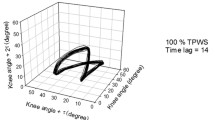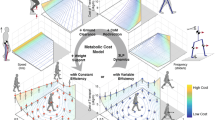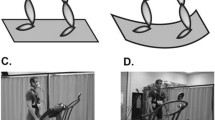Abstract
The purpose of this study was to test a theoretical model (Stein et al. 1986) which suggested that minimizing the rate of metabolic energy consumption (\(\dot V\)O2) is related to minimizing jerk (third derivative of position) during human movement. At a given speed of walking, \(\dot V\)O2 has been shown to increase curvilinearly as stride length (SL) is varied from freely chosen stride length (FCSL). It was hypothesized that the jerk-cost, or JC (area under squared jerk curve), would exhibit similar behavior. Subjects (n=24) walked (1.75 m ·. s−1) on a treadmill at FCSL, and at SL derivations at ± 10 and ±20% of leg length from FCSL until steady-state \(\dot V\)O2 was attained. Videotaping (60 Hz) in the sagittal plane and subsequent digitizing of relevant markers produced position coordinates which were smoothed and normalized in both distance and time before calculating the third time derivative to obtain two-dimensional JC values. The expected response of \(\dot V\)O2 to deviations in SL was found (minimum at FCSL), but JC increased with SL except at the two longest SL conditions. A weak but statistically significant negative correlation was found between \(\dot V\)O2 and JC, suggesting that smoothness and economy are not complementary performance criteria during walking.
Similar content being viewed by others
References
Alexander RM (1989) Optimization and gaits in the locomotion of vertebrates. Physiol Rev 69:1199–1227
Atkeson CG (1989) Learning arm kinematics and dynamics. Ann Rev Neurosci 12:157–183
Atkeson CG, Hollerbach JM (1985) Kinematic features of unrestrained vertical arm movements. J Neurosci 5:2318–2330
Brooks VB (1986) The neural basis of motor control. Oxford University Press, New York
Cavanagh PR, Williams K (1982) The effect of stride length variation on oxygen uptake during distance running. Med Sci Sports Exercise 14:30–35
Flash T (1987) The control of hand equilibrium trajectories in multi-joint arm movements. Biol Cybern 57:257–274
Flash T (1990) The organization of human arm trajectory control. In: Winters JM, Woo SL-Y (eds) Multiple muscle systems: biomechanics and movement organization. Springer, Berlin Heidelberg New York, pp 282–301
Flash T, Hogan N (1985) The coordination of arm movements: an experimentally confirmed mathematical model. J Neurosci 5:1688–1703
Heglund NC, Taylor CR (1988) Speed, stride frequency and energy cost per stride, how do they change with body size and gait? J Exp Biol 138:301–318
Hogan N (1988) Planning and execution of multijoint movements. Can J Physiol Pharmacol 66:508–517
Hogan N (1990) Mechanical impedance of single- and multi-articular systems. In: Winters JM, Woo SL-Y (eds) Multiple muscle systems: biomechanics and movement organization. Springer, Berlin Heidelberg New York, pp 149–164
Hogan N, Winters JM (1990) Principles underlying movement organization: upper limb. In: Winters JM, Woo SL-Y multiple muscle systems: biomechanics and movement organization, Springer, Berlin Heidelberg New York, pp 182–194
Hogan N, Bizzi E, Mussa-Ivaldi FA, Flash T (1987) Controlling multi-joint motor behavior. Exerc Sport Sci Rev 15:153–189
Hollerbach JM, Atkeson CG (1987) Deducing planning variables from experimental arm trajectories: pitfalls and possibilities. Biol Cybern 56:279–292
Hoyt DF, Taylor CR (1981) Gait and the energetics of locomotion in horses. Nature 292:239–240
Hreljac A (1993) The relationship between smoothness and performance during the practice of a lower limb obstacle avoidance task. Biol Cybern 68:375–379
Kaneko M, Matsumoto M, Ito A, Fuchimoto T (1987) Optimum step frequency in constant speed running. In: Jonsson B (ed) Biomechanics X-B. Human Kinetics, Champaign, Ill, pp 803–810
Margaria R, Cerretelli P, Aghemo P, Sassi G (1963) Energy cost of running. J Appl Phsyiol 18:367–370
Morgan DW, Martin PE (1986) Effects of stride length alteration on race-walking economy. Can J Appl Sports Sci 11:211–217
Nelson WL (1983) Physical principles for economies of skilled movements. Biol Cybern 46:135–147
Schneider K, Zernicke RF (1989) Jerk-cost modulations during the practice of rapid arm movements. Biol Cybern 60:221–230
Seif-Naraghi AH, Winters JM (1990) Optimized strategies for scaling goal-directed dynamic limb movements. In: Winters JM, Woo SL-Y (eds) Multiple muscle systems: biomechanics and movement organization. Springer, Berlin Heidelberg New York, pp 312–334
Stein RB, Oğuztöreli MN, Capaday C (1986) What is optimized in muscular movements? In: Jones NL, McCartney N, McComas AJ (eds) Human muscle power. Human Kinetics, Champaign, Ill, pp 131–150
Wells RP, Winter DA (1980) Assessment of signal and noise in the kinematics of normal, pathological, and sporting gaits. In: Human locomotion I. Proceedings of the special conference of the Canadian Society for Biomechanics, Oct 27–29, London Ontario, pp 92–93
Winstein CJ, Schmidt RA (1989) Sensorimotor feedback. In; Holding D (ed) Human skills. Wiley, New York, pp 17–47
Zajac FE, Winters JM (1990) Modeling musculoskeletal movement systems: joint and body segmental dynamics, musculoskeletal actuation, and neuromuscular control. In: Winters JM, Woo SL-Y (eds) Multiple muscle systems: biomechanics and movement organization. Springer, Berlin Heidelberg New York, pp 121–148
Author information
Authors and Affiliations
Rights and permissions
About this article
Cite this article
Hreljac, A., Martin, P.E. The relationship between smoothness and economy during walking. Biol. Cybern. 69, 213–218 (1993). https://doi.org/10.1007/BF00198961
Received:
Accepted:
Issue Date:
DOI: https://doi.org/10.1007/BF00198961




